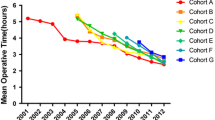Abstract
Purpose
The late postoperative complications of choledochal cyst (CC) surgery are serious and include intrahepatic stones and biliary carcinoma; therefore, long-term follow-up is crucial.
Methods
The subjects of this retrospective study were patients who underwent surgery for CC at Kagoshima University Hospital between April, 1984 and December, 2016. We analyzed the operative results, early and late postoperative complications, and postoperative follow-up rate.
Results
The study population comprised 110 CC patients (male/female: 33/77) with a median age at surgery of 4 years, 3 months (range 12 days–17 years). The patients underwent hepaticoduodenostomy (n = 1; 0.9%) or hepaticojejunostomy (n = 109; 99.1%). Late complications included intrahepatic bile duct (IHBD) dilatation (n = 1; 0.9%), IHBD stones (n = 3; 2.7%), and adhesive ileus (n = 4; 3.6%). There was no incidence of biliary carcinoma in this series. The rates of follow-up at our institute within 10 years of surgery and more than 20 years after surgery were 69.2% (18 of 26) and 14.5% (8 of 55), respectively.
Conclusions
The follow-up rate after definitive surgery declined with time. Late complications were observed within 20 years, but biliary carcinoma was not observed. The follow-up rate should be increased to detect late complications. Moreover, patient education on long-term follow up is essential to prevent life-threatening events after definitive surgery for CC.

Similar content being viewed by others
References
Babbitt DP. Congenital choledochal cysts: new etiological concept based on anomalous relationships of the common bile duct and pancreatic bulb. Ann Radiol (Paris). 1969;12:231–40.
Singham J, Yoshida EM, Scudamore CH. Choledochal cysts: part 2 of 3: diagnosis. Can J Surg. 2009;52:506–11.
Edil BH, Cameron JL, Reddy S, Lum Y, Lipsett PA, Nathan H, et al. Choledochal cyst disease in children and adults: a 30-year single-institution experience. J Am Coll Surg. (2008);206:1000–5, (discussion 5–8).
Nagi B, Kochhar R, Bhasin D, Singh K. Endoscopic retrograde cholangiopancreatography in the evaluation of anomalous junction of the pancreaticobiliary duct and related disorders. Abdom Imaging. 2003;28:847 – 52.
Ishibashi H, Shimada M, Kamisawa T, Fujii H, Hamada Y, Kubota M, et al. Japanese clinical practice guidelines for congenital biliary dilatation. J Hepat Pancreat Sci. 2017;24:1–16.
She WH, Chung HY, Lan LC, Wong KK, Saing H, Tam PK. Management of choledochal cyst: 30 years of experience and results in a single center. J Pediatr Surg. 2009;44:2307–11.
Todani T, Watanabe Y, Toki A, Morotomi Y. Classification of congenital biliary cystic disease: special reference to type Ic and IVA cysts with primary ductal stricture. J Hepat Pancreat Surg. 2003;10:340–4.
Takeshita N, Ota T, Yamamoto M. Forty-year experience with flow-diversion surgery for patients with congenital choledochal cysts with pancreaticobiliary maljunction at a single institution. Ann Surg. 2011;254:1050–3.
Todani T, Watanabe Y, Urushihara N, Noda T, Morotomi Y. Biliary complications after excisional procedure for choledochal cyst. J Pediatr Surg. 1995;30:478 – 81.
Chijiiwa K, Tanaka M. Late complications after excisional operation in patients with choledochal cyst. J Am Coll Surg. 1994;179:139 – 44.
Saing H, Han H, Chan KL, Lam W, Chan FL, Cheng W, et al. Early and late results of excision of choledochal cysts. J Pediatr Surg. 1997;32:1563–6.
Tsuchida Y, Takahashi A, Suzuki N, Kuroiwa M, Murai H, Toki F, et al. Development of intrahepatic biliary stones after excision of choledochal cysts. J Pediatr Surg. 2002;37:165–7.
Ono S, Maeda K, Baba K, Usui Y, Tsuji Y, Yano T, et al. The efficacy of double-balloon enteroscopy for intrahepatic bile duct stones after Roux-en-Y hepaticojejunostomy for choledochal cysts. Pediatr Surg Int. 2013;29:1103–7.
Watanabe Y, Toki A, Todani T. Bile duct cancer developed after cyst excision for choledochal cyst. J Hepat Pancreat Surg. 1999;6:207 – 12.
Kobayashi S, Asano T, Yamasaki M, Kenmochi T, Nakagohri T, Ochiai T. Risk of bile duct carcinogenesis after excision of extrahepatic bile ducts in pancreaticobiliary maljunction. Surgery. 1999;126:939 – 44.
Wang D, Liu Z, Li Z, Li D, Chen J, Zheng S, et al. Surgical treatment of congenital biliary duct cyst. BMC Gastroenterol. 2012;12:29.
Zheng X, Gu W, Xia H, Huang X, Liang B, Yang T, et al. Surgical treatment of type IV-A choledochal cyst in a single institution: children vs. adults. J Pediatr Surg. 2013;48:2061–6.
Ono S, Sakai K, Kimura O, Iwai N. Development of bile duct cancer in a 26-year-old man after resection of infantile choledochal cyst. J Pediatr Surg. 2008;43:E17-9.
Shimamura K, Kurosaki I, Sato D, Takano K, Yokoyama N, Sato Y, et al. Intrahepatic cholangiocarcinoma arising 34 years after excision of a type IV-A congenital choledochal cyst: report of a case. Surg Today. 2009;39:247 – 51.
Ohashi T, Wakai T, Kubota M, Matsuda Y, Arai Y, Ohyama T, et al. Risk of subsequent biliary malignancy in patients undergoing cyst excision for congenital choledochal cysts. J Gastroenterol Hepatol. 2013;28:243–7.
Ng DW, Chiow AK, Poh WT, Tan SS. Metachronous cholangiocarcinoma 13 years post resection of choledochal cyst-is long-term follow-up useful?: a case study and review of the literature. Surg Case Rep. 2016;2:60.
Acknowledgements
This study was supported by a Grant-in-Aid for Scientific Research from the Japan Society for the Promotion of Science (JSPS, Nos. 16K10466, 16K10094, 16K10095, 16K10434, 16H07090, 17K10555, 17K11514, 17K10183, 17K11515), a Research Grant from President’s Discretionary Expenses of Kagoshima University, a Research Grant from The UBE Foundation, a Research Grant from Kawano Masanori Memorial Public Interest Incorporated Foundation for Promotion of Pediatrics, a Research Grant from Tateishi Science and Technology Foundation, a Research Grant from Mitsui Life Social Welfare Foundation, and a Research Grant from The Kurata Grants of the Hitachi Global Foundation.
Author information
Authors and Affiliations
Corresponding author
Ethics declarations
Conflict of interest
We have no conflicts of interest to declare in association with the present study.
Rights and permissions
About this article
Cite this article
Mukai, M., Kaji, T., Masuya, R. et al. Long-term outcomes of surgery for choledochal cysts: a single-institution study focusing on follow-up and late complications. Surg Today 48, 835–840 (2018). https://doi.org/10.1007/s00595-018-1660-9
Received:
Accepted:
Published:
Issue Date:
DOI: https://doi.org/10.1007/s00595-018-1660-9




